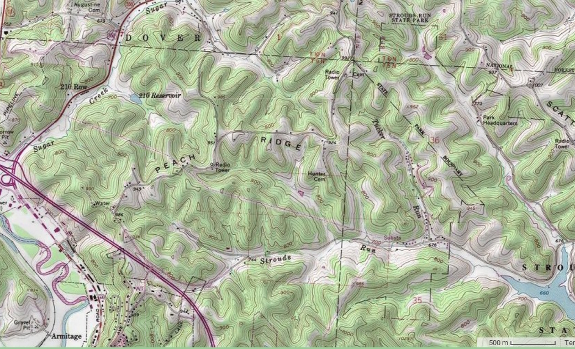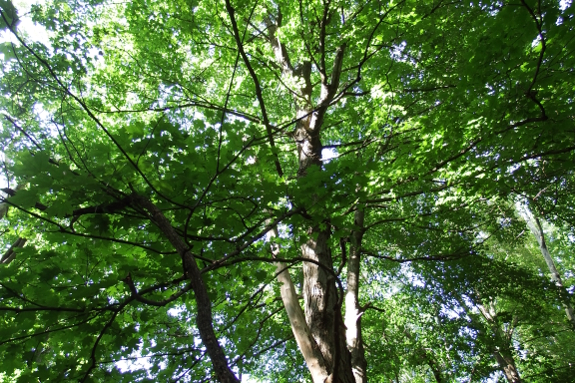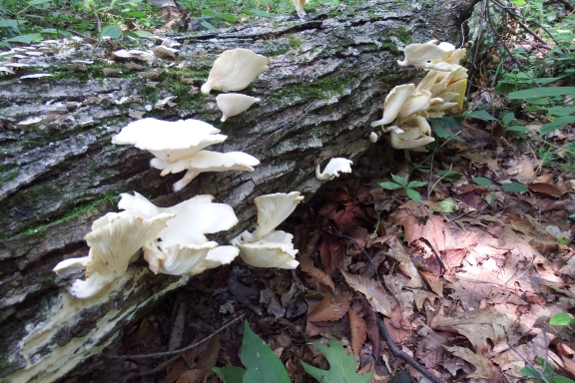
Gardening on a ridge versus in a valley

The property Mark and I
are currently considering is on top of a ridge --- high and dry.
Microclimates have such a huge impact on gardening, and there are major
pros and cons to ridges over our current valley location.

On the minus side,
ridges are more exposed to storms and wind, something we've never had
to worry about in the past. In an area where rainfall is already 20%
down from what I'm used to and where we'd be depending on city water,
we'd have to get more clever about irrigation and rainwater catchment.
Meanwhile soil also tends to be less rich on ridgetops since erosion
naturally carries topsoil downhill.

That said, never again
having to deal with waterlogged soil has something to recommend itself
after over a decade in what I lovingly call a swamp. Fungal diseases
should be rarer and ridgetops can (at least sometimes) be less
susceptible to late spring freezes since cold air naturally flows
downhill during the course of a night. And we wouldn't have to put up
with the lack of winter sun that further chills our current farm
either, which may make a ridgetop in zone 6A no harder for tender
plants to survive than a north-facing bottom in zone 6B.
I'd be curious from
those of you currently gardening on ridges. What other pros and cons
would you put out there about these more exposed locations?
Want more in-depth information? Browse through our books.
Or explore more posts by date or by subject.
About us: Anna Hess and Mark Hamilton spent over a decade living self-sufficiently in the mountains of Virginia before moving north to start over from scratch in the foothills of Ohio. They've experimented with permaculture, no-till gardening, trailersteading, home-based microbusinesses and much more, writing about their adventures in both blogs and books.
Want to be notified when new comments are posted on this page? Click on the RSS button after you add a comment to subscribe to the comment feed, or simply check the box beside "email replies to me" while writing your comment.

Pros: Often a lovely view, with sunsets and sunrises Breezes Few drainage problems Privacy - you see see or hear who's coming
Cons: Erosion High winds, so you have to be careful where you plant tall crops or put up wind breaks Poor soil, so you have to amend a lot and/or build raised beds
I have found that the bogginess of the location is mostly soil-dependent. There are areas on the ridge that are dry, and others that become mushy when there's a heavy rain.
I live on a humid ridge top and I can tell you that fungal diseases are NOT rarer! In fact, this year is the worst so far! Another thing that I have to deal with are crows. I have scarecrows, CDs, netting, you name it.
Every piece of land, comes with some tweaking. We have a north and south facing slope, with a valley where they both meet. We also have various gullies across the slopes. Where we have worked on the slopes, we've managed to retain more moisture. The slopes we haven't altered, are very dry.
The strategies for retaining moisture on slopes are, swales, hugelkultur, and/or hedgerows - built on contour. Any of these, will interrupt the path of water going down hill, and capture it. That's really the trick for gardening on slopes, by creating barriers to defy gravity. They say the best place to garden/live is the middle of a ridge. So not up the very top of the mountain, or down in the valley.
We built our house in the middle of our north facing slope (Southern Hemisphere) which is equivalent to your south facing slope. We can grow subtropical/tropical plants near the top of the slope, and temperate crops below. Of course, the wind is less in the valley, and more intense the further up the hill you go. It's difficult to plant windbreaks on a slope, because you have to have really tall trees, which can interrupt sun exposure.
Having experienced a range of different terrain on our particular block, the sweet spot is located in the middle of a ridge.